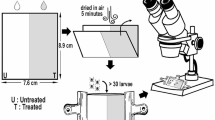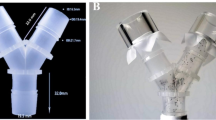Abstract
The repellent activity of eugenol was evaluated on Rhipicephalus microplus and Dermacentor nitens larvae in a bioassay based on the vertical migration of these tick larvae during the host-seek phase. Solutions were used at concentrations of 10, 20, 30, 40, and 50 μl/ml and a control only with the solvent ethanol 50 GL. The larvae's reaction of climbing the rods of filter paper was observed each hour for 12 h and once more at 24 h. The repellence was calculated as a percentage through visual estimation, from the tendency of the larvae to climb the rods when the top part was impregnated with the eugenol solutions. For R. microplus larvae, the four highest concentrations produced repellence levels were greater than 80 % for up to 9 h. The repellence rates after 10 h for the concentration of 10 μl/ml was lower than 2 % (p > 0.05); and after 24 h, the values observed for the concentrations of 40 and 50 μl/ml were 77 and 80 % (p < 0.05). For the D. nitens larvae, the repellence was greater than 80 % for up to 5 h at the concentrations of 40 and 50 μl/ml; and after 9 h, the repellence fell for all treated groups were significantly different than the control were found only at the three highest concentrations. Therefore, eugenol has repellent activity on the larval stage of these two tick species, with the R. microplus larvae being more sensitive.




Similar content being viewed by others
References
Asha MK, Prashanth D, Murali B, Padmaja R, Amit A (2001) Anthelmintic activity of essential oil of Ocimum sanctum and eugenol. Fitoterapia 72(6):669–670
Ayres M, Ayres Junior M, Ayres DL, Santos AAS (2007) Aplicações estatísticas nas áreas das ciências bio-médicas. Instituto Mamirauá, Belém
Bello ACPP, Cunha AP, Leite RC, Oliveira PR, Ribeiro ACC, Domingues LN, Freitas CMV, Bastianetto E, Rosa RCD (2008) Controle de Anocentor nitens (Neumann, 1897) (Acari: Ixodidae) em equinos. Rev Bras Parasiol Vet 17(1):59–63
Bizzo HR, Hovell AMC, Rezende CM (2009) Óleos essenciais no Brasil: aspectos gerais, desenvolvimento e perspectivas. Quím Nova 32(3):588–594
Borges LMF, Oliveira PR, Ribeiro MFB (2000) Seasonal dynamics of Anocentor nitens on horses in Brazil. Vet Parasitol 89:165–171
Borges LMF, Sousa LAD, Barbosa CS (2011) Perspectives for the use of plant extracts to control the cattle tick Rhipicephalus (Boophilus) microplus. Rev Bras Parsitol Vet 20(2):89–96
Brown HA, Minott DA, Ingram CW, Williams LAD (1998) Biological activities of the extracts and constituents of Pimenta Dioica L. against the southern cattle tick, Boophilus microplus. Insect Sci Applíc 18(1):9–16
Chagas ACS (2004) Controle de parasitas utilizando extratos vegetais. Rev Bras Parasitol Vet 13:156–160
Daemon E, Monteiro CMO, Rosa LS, Clemente MA, Arcoverde A (2009) Evaluation of the acaricide activity of thymol on engorged and unengorged larvae of Rhipicephalus sanguineus (Latreille, 1808) (Acari: Ixodidae). Parasitol Res 105:495–497
Daemon E, Monteiro CM, Maturano R, Senra TOS, Calmon F, Faza A, Prata MCA, Georgopoulos SL, de Oliveira LF (2012) Spectroscopic evaluation of thymol dissolved by different methods and influence on acaricidal activity against larvae of Rhipicephalus microplus (Acari: Ixodidae). Parasitol Res 111:1901–1906
Del Fabro S, Nazzi F (2008) Repellent effect of sweet basil compounds on Ixodes ricinus ticks. Exp Appl Acarol 45(3):219–228
Franz C, Novak J (2009) Sources of Essential Oils. In: Baser KHC, Buchbauer G (eds) Handbook of Essential Oils: Science, Technology and Applications. CRC Press, New York, pp 39–81
Furlong J, Martins JR, Prata MCA (2007) O carrapato dos bovinos e a resistência: temos o que comemorar? A Hora Vet 27(159):1–7
Grisi L, Massard CL, Moya-Borja GE, Pereira JB (2002) Impacto econômico das principais ectoparasitoses em bovinos no Brasil. A Hora Vet 21(125):8–10
Guimarães JH, Tucci EC, Barros-Battesti DM (2001) Ectoparasitos de importância veterinária. Plêiade/FAPESP, São Paulo
Kiss T, Cadar D, Spînu M (2012) Tick prevention at a crossroad: new and renewed solutions. Vet Parasitol 187:357–366
Kumar A, Shukla R, Singh P, Dubey NK (2010) Chemical composition, antifungal, and antiaflatoxigenic activities of Ocimum sanctum L. essential oil and its safety assessment as plant based antimicrobial. Food Chem Toxicol 48:539–543
Mendes AS, Daemon E, Monteiro CMO, Maturano R, Brito FC, Massoni T (2011) Acaricidal activity of thymol on larvae and nymphs of Amblyomma cajennense (Acari: Ixodidae). Vet Parasitol 183:136–139
Monteiro CM, Maturano R, Catunda-Junior FEA, Calmon F, Senra TS, Faza A, Carvalho MG (2012) Acaricidal activity of eugenol on Rhipicephalus microplus (Acari: Ixodidae) and Dermacentor nitens (Acari: Ixodidae) larvae. Parasitol Res 111(3):1295–300
Nascimento GGF, Locateli J, Freitas PC, Silva GL (2000) Antibacterial activity of plant extracts and phytochemicals on antibiotic resistant bacteria. Braz J Microbiol 31:247–256
Nerio LS, Jesus OV, Stashenko E (2010) Repellent activity of essential oils: a review. Bioresour Technol 101:372–378
Novelino MAS, Daemon E, Soares GLG (2007) Avaliação da atividade repelente do timol, mentol, salicilato de metila e ácido salicilico sobre larvas de Boophilus microplus (Canestrini, 1887) (Acari: Ixodidae). Arq Bras Med Vet Zootec 59(3):700–704
Oliveira RA, Reis TV, Sacramento CK, Duarte LP, Oliveira FF (2009) Constituintes químicos voláteis de especiarias ricas em eugenol. Rev Bras Farmac 19(3):771–775
Oussalah M, Caillet S, Saucier L, Lacroix M (2006) Antimicrobial effects of selected plant essential oils on the growth of a Pseudomonas putida strain isolated from meat. Meat Sci 73:236–244
Pereira MC, Labruna MB (2008) Rhipicephalus (Boophilus) microplus. In: Pereira MC, Labruna MB, Szabó MPJ, Klafke GM (eds) Biologia, Controle e Resistência. Med Vet, São Paulo, pp 15–53
Ponce AG, Fritz R, del Valle C, Roura SI (2003) Antimicrobial activity of essential oils on the native microflora of organic Swiss chard. Lebensm-Wiss u-Technol 36:679–684
Roby TO, Anthony DW (1963) Transmission of equine piroplasmosis by Dermacentor nitens Neumann. J Am Vet Med Assoc 142(2):768–769
Semmler M, Abdel-Ghaffar F, Al-Rasheid K, Mehlhorn H (2009) Nature helps: from research to products against blood-sucking arthropods. Parasitol Res 105(6):1483–1487
Soares SF, Borges LMF, Braga RS, Ferreira LL, Louly CCB, Tresvenzol LMF, Paula JR, Ferri PH (2010) Repellent activity of plant-derived compounds against Amblyomma cajennense (Acari: Ixodidae) nymphs. Vet Parasitol 167(1):67–73
Tawatsin A, Wratten SD, Roderic Scott R, Thavara U, Techadamrongsin Y (2001) Repellency of volatile oils from plants against three mosquito vectors. J Vect Ecol 26(1):76–82
Thorshell W, Mikiver A, Tunon H (2006) Repelling properties of some plant materials on the tick Ixodes ricinus. Phytomed 13:132–134
Author information
Authors and Affiliations
Corresponding author
Rights and permissions
About this article
Cite this article
Zeringóta, V., Senra, T.O.S., Calmon, F. et al. Repellent activity of eugenol on larvae of Rhipicephalus microplus and Dermacentor nitens (Acari: Ixodidae). Parasitol Res 112, 2675–2679 (2013). https://doi.org/10.1007/s00436-013-3434-z
Received:
Accepted:
Published:
Issue Date:
DOI: https://doi.org/10.1007/s00436-013-3434-z




